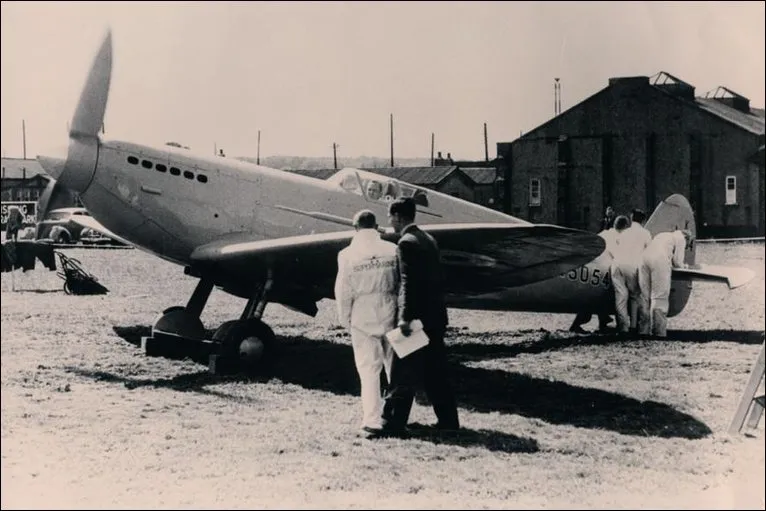The Supermarine Spitfire stands as a symbol of British resilience and engineering excellence during World War II. Renowned for its role in dogfighting, particularly during the Battle of Britain, the Spitfire's true legacy lies in its constant innovation and versatility. This fighter plane wasn't just a single aircraft but a series of ever-evolving models, or "Marks," each refined to meet the changing demands of warfare. This continuous development, combined with its adaptability in various combat roles, made the Spitfire one of the most formidable and flexible fighting machines of the war.
The genesis of an icon
The Spitfire's origins are rooted in the visionary work of Reginald J. Mitchell, who initially drew on his experience designing racing seaplanes. The first Spitfire prototype, the K5054, took flight on March 5, 1936, showcasing its exceptional speed, agility, and advanced aerodynamics. These qualities were crucial as the threat from Germany's Luftwaffe grew more imminent.
The initial production model, the Spitfire Mk I, entered service with the Royal Air Force (RAF) in 1938, just before the outbreak of World War II. Powered by a Rolls-Royce Merlin engine, it could reach speeds of around 362 mph and was armed with eight .303 Browning machine guns. Its performance in the early war years, especially during the Battle of Britain, cemented its reputation. However, as the conflict intensified, the need for improvements became apparent, leading to the Spitfire's ongoing refinement throughout the war.
Evolution through innovation
The Spitfire was not a static design but a platform that evolved rapidly in response to new challenges. More than 20 different Marks of Spitfire were developed, with each tailored to meet specific and emerging operational needs.
Spitfire Mk II: Introduced in late 1940, the Mk II featured an upgraded Merlin XII engine and improved armour. These enhancements provided better performance during the closing stages of the Battle of Britain and extended the aircraft's operational range with auxiliary fuel tanks.
Spitfire Mk V: The Mk V, which appeared in early 1941, was one of the most produced versions. It featured the more powerful Merlin 45 engine, and was equipped with two 20mm Hispano cannons, with four machine guns (in some variants) boosting its firepower. The Mk V was also developed in a "clipped" wing version, which improved low-altitude manoeuvrability and roll rates.
Spitfire Mk IX: As a direct response to the formidable Focke-Wulf Fw 190, the Mk IX was introduced in 1942. It featured the Merlin 61 engine with a two-stage supercharger, significantly improving high-altitude performance. This Mark became a critical tool in regaining and maintaining air superiority over Europe.
Spitfire Mk XIV: The introduction of the Rolls-Royce Griffon engine in the Mk XIV marked a significant leap forward. The Griffon 65 engine produced 2,050 horsepower, allowing the Mk XIV to reach speeds of 448 mph and effectively counter newer German aircraft. This model saw extensive use in the later stages of the war.
Spitfire Mk XVI and beyond: The Mk XVI, powered by an American-built Packard Merlin engine, featured a bubble canopy for better pilot visibility and was effective in ground attack roles. The final operational variant, the Mk 24, introduced post-war, demonstrated the Spitfire's capacity for adaptation even beyond the immediate needs of WWII.
Versatility in combat
The Spitfire's adaptability wasn't limited to its airframe and engine upgrades: throughout the war, it was employed in a range of roles, from dive bombing to aerial reconnaissance, in addition to its dog fighting role.
Dog fighting: master of the skies
Primarily designed as an air superiority fighter, the Spitfire excelled in dogfighting. Its superior manoeuvrability, provided by its elliptical wings, allowed it to outturn many adversaries, including the Messerschmitt Bf 109. The Spitfire's ability to quickly climb, engage, and disengage in combat made it a feared opponent. Throughout the war, even as enemy aircraft evolved, the Spitfire's continuous improvements ensured it remained a dominant force in aerial combat.
Dive bombing: from fighter to bomber
The demands of the war required the Spitfire to take on additional roles, including dive bombing. Later models, such as the Mk V, were equipped to carry bombs, turning them into effective dive bombers. These aircraft played a crucial role in ground attack missions, targeting enemy fortifications, supply lines, and vehicles. While it wasn't designed for this role, the Spitfire's adaptability meant it performed this role with great success, as can be seen from the experiences of two Australian Spitfire pilots, Flying Officer Cecil Zuber and Flying Officer John Laffan.
Operation Diver and Operation Big Ben
The battle against Hitler's Vergeltungswaffen or Retaliatory Weapon, the notorious V1 and V2 was in full swing. The sorties flown by 602 Squadron RAF concentrated on these threats. The campaigns code named Operation Diver (anti-V1) and Operation Big Ben (anti-V2), were to prove dangerous and pivotal in reducing the threat, at the source.
Operation Big Ben was so secret it remained largely classified until 2004. These sorties by 602, 603, 124 and RAAF 457 Squadrons, acting on intelligence fed back to Fighter Command through Operation Crossbow was planned by a new group known as the Special Operations Executive (SOE). SOE were tasked with gathering intelligence from Western Europe through covert operations behind enemy lines. This important and highly dangerous work was vital to the war effort by identifying targets of interest for Fighter and Bomber Commands.
Patrols over the Canadian Atlantic coast did not prepare Cec for the real war. His first mission was a bombing raid on enemy shipping in Den Helder Harbour in The Netherlands. With a 250-pound bomb strapped to each wing and a 500-pound bomb slung under the fuselage, Cec and five other Spitfires set course for their target. Crossing the North Sea at 5000 feet, the Spitfires entered a steep dive just before they reached the harbour. With guns and canons firing at them from the ships and flak shells bursting all around from the land defences, they released their bombs at just under a thousand feet.
Cec openly admitted to being completely terrified and had no idea where his bombs landed, sure he had hit nothing. It was a sobering experience for the 22-year-old. This raid brought the reality of his new life into sharp focus concentrating his mind on his flying from then on.
Cec's long-time friend, and fellow Spitfire pilot shares his memories of his experience of using the Spitfire as a dive bomber in the Temora Aviation Museum's Unsung Heroes video stories: John Laffan.
Aerial reconnaissance: Spitfire eye in the sky
A lesser known but vital role for the Spitfire was aerial reconnaissance. Specially modified (PR) Photo Reconnaissance variants were used to gather intelligence on enemy positions and movements. These unarmed Spitfires were stripped of their guns to reduce weight and increase fuel capacity, allowing them to fly longer distances and at higher altitudes, often beyond the reach of enemy fighters and anti-aircraft fire. The intelligence gathered by these Spitfires was invaluable in planning Allied operations and bombing campaigns.
Coastal patrol and anti-shipping operations
The Spitfire also played a role in protecting Allied shipping lanes and attacking enemy vessels. In coastal patrol and anti-shipping operations, Spitfires were equipped with cannons, machine guns, and sometimes rockets to disrupt enemy supply routes and defend against fast-moving boats and submarines. Their speed and firepower made them effective in these roles, ensuring the safety of vital supply convoys.
Close air support for the Allies ground troops
In major operations such as the D-Day invasion, Spitfires provided essential close air support to ground forces. They strafed enemy positions, disrupted supply lines, and attacked armoured vehicles, directly supporting Allied troops as they advanced. The Spitfire's ability to operate at low altitudes and accurately deliver its payload made it an asset in these operations, despite the increased risk from ground-based defences.
Conclusion: innovation and flexibility define the Spitfire's legacy
The Supermarine Spitfire's success during World War II was due to its superiority in aerial dogfights as well as its continuous innovation and flexibility across a wide range of combat roles. From its early days as a cutting-edge fighter to its evolution into a multi-role aircraft capable of dive bombing, reconnaissance, and ground support, the Spitfire was a true chameleon of the skies.
This adaptability was possible because of the tireless efforts of engineers, designers, and pilots who recognised the need for constant improvement in response to the ever-changing demands of warfare.
The Spitfire's legacy is one of relentless innovation and versatility—a legacy that not only secured its place in history as one of the most iconic aircraft of World War II but also set a standard for how adaptability and continuous development can turn a single platform into a multi-faceted tool of war.



